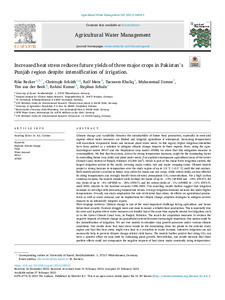| dcterms.abstract | Climate change and variability threaten the sustainability of future food production, especially in semi-arid regions where water resources are limited and irrigated agriculture is widespread. Increasing temperatures will exacerbate evaporative losses and increase plant water needs. In this regard, higher irrigation intensities have been posited as a solution to mitigate climate change impacts in these regions. Here, using the agrohydrological model SWAT and the biophysical crop model APSIM, we show that this mitigation measure is oversimplified. We find that heat stress, driven by strong temperature increases, might be the dominating factor in controlling future crop yields and plant water needs. Our analysis encompasses agricultural areas of the Lower Chenab Canal System in Punjab, Pakistan (15,000 km2), which is part of the Indus River irrigation system, the largest irrigation system in the world, covering major cotton, rice and maize cropping zones. Climate models project a strong increase in temperature over the study region of up to 1.8 ◦C (±0.5 ◦C) until the mid-century. Both models predict a decline in future crop yields for maize and rice crops, while cotton yields are less effected by rising temperatures and strongly benefit from elevated atmospheric CO2 concentrations. For a high carbon emission scenario, the models simulate yield declines for maize of up to - 10% (APSIM) and - 19% (SWAT); for rice yields of up to - 4% (APSIM) to - 26% (SWAT), and for cotton yields of - 1% (APSIM) to +11% (SWAT), until 2050, relative to the baseline scenario 1996–2005. Our modeling results further suggest that irrigation demands do not align with increasing temperature trends. Average irrigation demands increase less under higher temperatures. Overall, our study emphasizes the role of elevated heat stress, its effects on agricultural productivity as well as water demand, and its implications for climate change adaption strategies to mitigate adverse impacts in an intensively irrigated region.
Plain language summary: Climate change is one of the most important challenge facing agriculture, and hence future food security. Farmers struggle more and more to ensure a reliable food production. This is especially true for semi-arid regions where water resources are limited but at the same time urgently needed for irrigation, such as in the Lower Chenab Canal Area, in Punjab, Pakistan. The search for adaptation measures to weaken the negative impacts of climate change on agricultural systems becomes increasingly important. One option could be the intensification of irrigation. We use two models to simulate crop growth processes under various climate conditions. Our results show that heat stress would be the dominating stress for plants in the selected study region and that this heat stress might even lead to a reduction in water demand. Intensive irrigation can not necessarily help to prevent climate change-related yield losses. The models further predict that rising CO2 can have a positive effect on crop yield by enhancing plant growth. Nevertheless, our results indicate that these positive effects could not compensate the negative impacts of heat stress under constantly rising temperatures. | eng |


